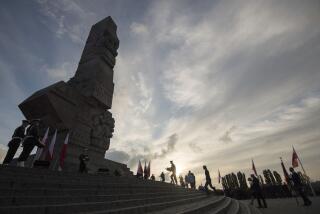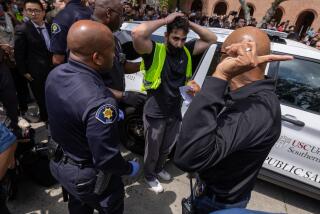Probe in Bosnia Seeks ‘Echoes’ of Mass Killing
ZELENI JADAR, Bosnia-Herzegovina — With each shovel of khaki-green mud, the sickening stench of death grew, finally overwhelming the frigid rain that fell on the hidden grave.
Slowly, with trowels and finally their gloved hands, seven war crimes investigators eased a skull, a leg and a clothed arm bone into view. They cataloged these and other “human remains” buried and scattered over a 40-yard shoulder of deserted rural road here in the mountains of Serb-held eastern Bosnia-Herzegovina.
For the last two weeks, members of the International Criminal Tribunal for the Former Yugoslavia have carried out their first inspection of sites where thousands of Muslim men who tried to flee the Bosnian Serb takeover of the U.N.-designated “safe area” of Srebrenica last year are believed to be buried.
The existence of the graves and the fate of the Srebrenica men have been partially documented through the accounts of witnesses and survivors and through U.S. spy satellite photography. But the tribunal’s probe represents the first collection and scientific examination of evidence that may be used to prosecute senior Bosnian Serb leaders and others accused of war crimes.
“You can look at a grave as an echo chamber--it will echo the accounts of witnesses,” said William Haglund, a former investigator with the Seattle County medical examiner’s office and a member of the Boston-based Physicians for Human Rights who is participating in the war crimes probe. “It will give you feedback that will substantiate, or not, the witnesses’ accounts of how a person died.”
War crimes prosecutions are seen by many Bosnians as the catharsis essential to a lasting peace and the rebuilding of their devastated country. But the investigations also carry the potential for political explosion, especially among Bosnian Serbs who view the process as biased against them.
Moreover, the prospect of anyone ever being brought to justice seems slim. Only four of 57 indicted suspects have actually been detained, and the chief among them--Bosnian Serb leader Radovan Karadzic and army commander Gen. Ratko Mladic--continue to rule their half of Bosnia from behind the scenes.
The Bosnia Serb army overran Srebrenica in July, driving an estimated 30,000 people into flight. According to human rights organizations, as many as 8,000 Muslim men are unaccounted for--many are believed to have been killed in ambushes or after capture--in what may have been the worst atrocity in Europe since World War II.
The investigators--among them an FBI agent from Boston, a French police chief and an American pathologist--have conducted their work under the escort of U.S. troops maintaining a watchful distance.
Sequestered on an American military base known as Camp Lisa in the town of Vlasenica, which is under Bosnian Serb control, the team has ventured out each day in a convoy with half a dozen American Humvees or Bradley fighting vehicles fitted with .50-caliber machine guns.
Guided by satellite photos that last autumn pinpointed half a dozen suspected grave sites in a 12-mile stretch of valleys and fields north and west of Srebrenica, the tribunal team has also surveyed a warehouse, an elementary school, a soccer field and other places where Muslim men are thought to have been rounded up, held or executed.
The Zeleni Jadar site, surveyed one day last week, was of special significance because it may bolster the case being made against Bosnian Serbs who are suspected of tampering with the graves in an effort to conceal evidence.
Different colors of dirt showed clearly where a 4-foot-deep layer had been added on top of an unknown number of bodies. Freshly broken tree branches and heavy-vehicle tracks bordered the location.
The one partial skeleton that the investigators exhumed was still clothed, although mud obscured the color of the clothing. Another shattered skull lay nearby, along with dozens of bone fragments and other evidence, samples of which were placed in plastic bags.
The investigators placed numbered yellow markers where they found evidence. No. 2, finger bone. No. 4, upper cranium. No. 5, clothing.
Zeleni Jadar is a previously unknown burial place and appears to be a site to which bodies were moved after having been buried at another location. Asked how the tribunal team discovered it, team leader Jean Rene Ruez would only say, “Technology might be of great help”--suggesting that it was detected through satellite surveillance.
Once they finished surveying, the investigators drove to another suspected mass grave at the town of Glogova and took dirt samples to compare with traces from Zeleni Jadar. Glogova is the largest of the sites, and there is ample evidence that it was disturbed or re-dug in October.
Other signs of more recent tampering have been found at another site, known as Sahanici. The suspected tampering apparently occurred after U.S. officials pledged to maintain aerial surveillance of the graves.
Reporters who visited the two large fields there saw chunks of disturbed dirt, yellow springtime flowers askew. Fragments of human bone, men’s jackets and what appear to be blindfolds have also been discovered at Sahanici.
Leaders of the 60,000-strong North Atlantic Treaty Organization-led peacekeeping force in Bosnia have refused to be drawn into the task of guarding the sites but have agreed to “observe” the areas “as assets are available.”
Faced with the possibility that the area was disturbed under his watch, U.S. Navy Adm. Leighton W. Smith, who commands the peacekeeping force, dispatched a team armed with digital cameras and high-tech position locaters to the site last week to take an accurate reading of geographical coordinates.
“We need to make sure we were looking at the right site,” one officer said.
The St. Sava elementary school is about half a mile away. Survivors have told reporters that hundreds of Muslim men who had surrendered or were captured from Srebrenica were rounded up in the school gym, taken out in groups, blindfolded and then trucked to the fields. There they were shot and dumped, and backhoes covered the bodies with dirt, the survivors say.
The survivors have reported seeing Mladic at the school at the time the men were being held.
Members of the tribunal team inspected the gym and the school--its interior walls freshly painted--and collected strips of cloth, thought to be blindfolds, that lay scattered on the school’s playground. As the investigators worked, children and young men played soccer on the same playground. A stray ball could have hit any of the investigators on the head.
This on-site investigation has not been exactly big-budget. The team has traveled in two white U.N. pickup trucks, and its most sophisticated equipment seems to be the tape recorders the investigators talk into, describing what they see, and one video camera.
Outside the St. Sava school, they were reduced to asking two Bosnian Serb police officers to watch their cars for them--cars replete with evidence likely to be used against the Bosnian Serbs. One of the officers later boasted of having participated in the takeover of Srebrenica and of relieving a trembling Dutch U.N. peacekeeper of his flak jacket.
The police officers said the strips of cloth that investigators believe to have been blindfolds were actually used to clean tanks parked at the school during the war.
Out of earshot of three American reporters, but not their Serbian interpreter, the two policemen then ridiculed the investigators and scoffed at their work.
“They are wasting their time,” one said. “They won’t find a thing.”
At another site, a warehouse near the town of Kravice, where Muslim men are thought to have been rounded up and shot with machine guns, investigators found substances they believed to be human blood, flesh and brain matter on the interior walls, along with numerous bullet holes.
And on Saturday, investigators went to a dam where survivors have said men were lined up and shot on a rocky plateau the size of two football fields. The team recovered bones, two clumps of hair and shell casings.
The goal of the tribunal investigators is to gather forensic evidence that will illustrate how victims died. The related mission of identifying the dead and returning their remains to their families--essential steps in resolving the uncertainty of thousands of Bosnians--has fallen to another task force whose work has barely begun.
That group has received 10,200 names of missing people, the vast majority of them Muslim, according to the International Committee of the Red Cross.
“You look at a skeleton and it tells you a story,” said Haglund, the forensic specialist from Physicians for Human Rights. “It tells you who the person was, how he lived and how he died.”
Members of Physicians for Human Rights, who are not permitted to discuss the Bosnia case specifically, are providing technical advice based on their experience in El Salvador, Guatemala and Rwanda.
To the likely continued anguish of relatives, identifications will not be easy. Accurate and complete information, such as extensive medical records, probably does not exist for the people who fled Srebrenica. And DNA testing is expensive.
The tribunal team was winding up its first surveying phase over the weekend and was to return to the tribunal headquarters at The Hague.
Full exhumations could begin next month.
More to Read
Sign up for Essential California
The most important California stories and recommendations in your inbox every morning.
You may occasionally receive promotional content from the Los Angeles Times.











